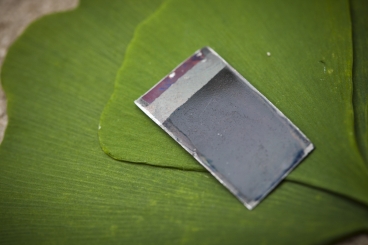Oct
6
Progress On The Synthetic Leaf
October 6, 2011 | Leave a Comment
MIT’s professor Daniel Nocera has a new paper published for a solar driven hydrogen splitting “leaf” that is made entirely of earth-abundant, inexpensive materials – mostly silicon, cobalt and nickel – that functions in ordinary water. Past work to produce devices that could use sunlight to split water have relied on corrosive solutions or on relatively rare and expensive materials such as platinum.
Nocera’s artificial leaf is a silicon solar cell with different catalytic materials bonded onto its two sides that need no external wires or control circuits to operate. Placed in a container of water and exposed to sunlight, it quickly begins to generate streams of bubbles: oxygen bubbles from one side and hydrogen bubbles from the other. If placed in a container that has a barrier to separate the two sides, the two streams of bubbles can be collected and stored, and used later to deliver power: for example, by feeding them into a fuel cell that combines them once again into water while delivering an electric current.
The property of releasing the hydrogen and the oxygen on different sides seizes attention. Production of hydrogen without the oxygen allows many more useful paths for the hydrogen as well as avoiding a step to separate the two. Most production splits the water and produces the elements combined, a highly volatile mixture called Brown’s gas.
The artificial leaf is a thin sheet of semiconducting silicon – the material most solar cells are made of – which turns the energy of sunlight into a flow of wireless electricity within the sheet. Bound onto the silicon is a layer of a cobalt-based catalyst, which releases oxygen, a material whose potential for generating fuel from sunlight was discovered by Nocera and his co-authors in 2008. The other side of the silicon sheet is coated with a layer of a nickel-molybdenum-zinc alloy, which releases hydrogen from the water molecules.
Nocera says, “I think there’s going to be real opportunities for this idea. You can’t get more portable – you don’t need wires, it’s lightweight, and it doesn’t require much in the way of additional equipment, other than a way of catching and storing the gases that bubble off. You just drop it in a glass of water, and it starts splitting it.”
At this point the technology sounds superb. Not fully satisfied, Nocera suggests one possible further development: tiny particles made of these materials that can split water molecules when placed in sunlight — making them more like photosynthetic algae than leaves. The advantage of that, he says, is that the small particles would have much more surface area exposed to sunlight and the water, allowing them to harness the sun’s energy more efficiently. Except engineering a system to separate and collect the two gases would be more complicated.
For now the new device is not yet ready for commercial production, since systems to collect, store and use the gases remain to be developed. “It’s a step,” Nocera says. “It’s heading in the right direction.”
Nocera’s vision is a future in which individual homes could be equipped with solar-collection systems based on this principle: Panels on the roof could use sunlight to produce hydrogen and oxygen that would be stored in tanks, and then fed to a fuel cell whenever electricity is needed. Such systems, Nocera hopes, could be made simple and inexpensive enough so that they could be widely adopted throughout the world, including many areas that do not presently have access to reliable sources of electricity. Enough roof area and one might power personal transport or offer hydrogen and oxygen for sale.
Presently the leaf can redirect about 2.5 percent of the energy of sunlight into hydrogen production in its wireless form; a variation using wires to connect the catalysts to the solar cell rather than bonding them together has attained 4.7 percent efficiency. The MIT article hasn’t addressed the costs directly saying Nocera’s ongoing research with the artificial leaf is directed toward pushing down the production costs as well as looking at ways of improving the system’s efficiency.
Without doubt, this technology path has potential. A solid-state cell with a lifespan measured in decades or more would have a very long amortization. The attraction is the hydrogen release without the oxygen. There are lots of technologies using electrolysis for splitting water, but clean hydrogen for storage is a great simplification worth quite a lot in capital cost and operation expense.
Nocera has started Sun Catalytix to commercialize his solar-energy inventions with paper co-author Steven Reece PhD ’07 working there. Lets hope the firm can get something truly low cost out for others to begin innovating with. Cheap hydrogen would be a great spark for new innovations.


